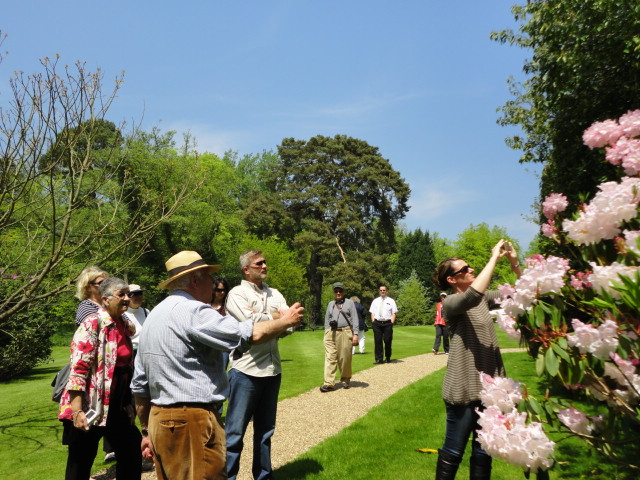Chateau de Villandry
Here is a wonderful restored Rennaissance château and garden, built on flat land by the banks of the River Cher near where it flows into the Loire. Dating originally from 1536 this is the last of the great Rennaissace châteaux built beside the Loire. The property passed through many hands and suffered many changes before it was bought in 1906 by the present owner’s grandfather Dr Joachim Carvallo, a Spaniard who had come to France to study medicine. He meticulously restored the buildings and made the garden that we see today, influenced by the book ‘Les Plus Excellents Bâtiments de France’ by J. A. du Cerceau (c1515-c1584).
Like a huge patchwork quilt, the garden is laid out on three levels to the south and west of the house. At the lowest level, divided into nine equal squares, is the ornamental kitchen garden, the potager. Each square is of a different design outlined by low box hedges. These beds are planted with a wonderful array of fruit and vegetables surrounded by ornamental annuals. The plantings are changed twice a year and are never exactly the same from year to year. In the spring there may be radishes, peas, oak-leaf lettuce, strawberries, sorrel, artichokes, chives and savory. These may be framed by rows of pansies of different colours, double white daisies and forget-me-nots. In the summer there will be ornamental cabbages of many kinds, gourds, leeks, tomatoes and many other vegetables carefully chosen for the beauty of their leaf and fruit. These will be edged with annual flowers – blue sage, verbenas and rudbeckias. All this is done in a dashing manner – the liveliness of the plant shapes and colours contrasting with the rigour of the design.
The second level is reached by steps leading under a long arbour covered in grape vines. Here is the Garden of Music, a great parterre, in which clipped box hedges and shapes surround massed plantings of herbaceous perennials and low shrubs (irises, asters, lavender, santolina and rosemary). Tall shapes of clipped yew and elegant single jets of water provide contrasting vertical notes in a chiefly horizontal plan. On the other side of a canal, at the same level, is the Garden of Love, another parterre with box hedges punctuated with clipped yew. Plantings in the beds are changed twice a year; in the spring pansies, stocks, tulips and forget-me-nots; in the summer dwarf dahlias in different colours.
On the third and final level there is a complete contrast – described in their book ‘The Gardens of Europe’ by Penelope Hobhouse and Patrick Taylor as “.. like a refreshing lemon sorbet after a delicious, but rich meal”. Here, lawns surround a large calm pool and smaller pools with single jets of water. A walk of pleached limes enclose the whole, from which visitors look down on the wonderful garden tapestry that lies below. Set to one side to the west of the parterres are a handsome maze and a collection of medicinal herbs.
Although this garden is complex, it’s never overwhelming. Despite the strict formality of its design, there is about it much liveliness and variety. It is maintained to a very high standard. It has become a tourist attraction of compelling allure, with which only Versailles and perhaps Giverny can compare.

 Passionate about beautiful gardens? Experience the finest gardens on one of our small and friendly group tours.
Passionate about beautiful gardens? Experience the finest gardens on one of our small and friendly group tours.
 Ready to book?
Ready to book? 
